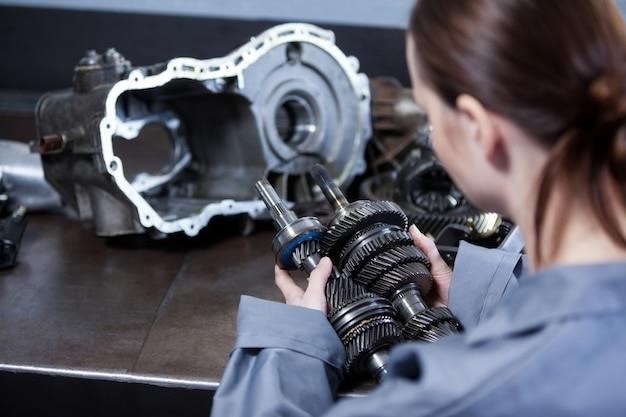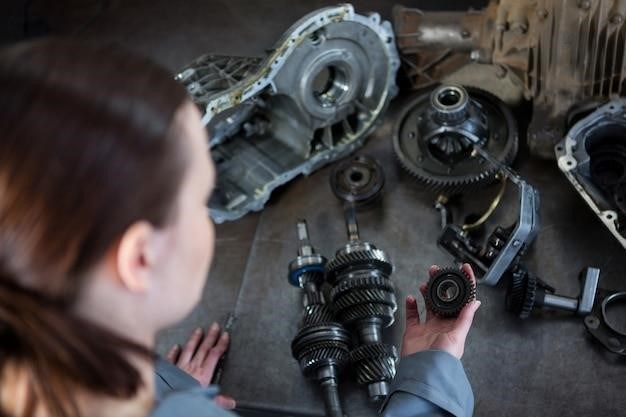Can You Change a Manual Transmission to Automatic?
Converting a manual transmission vehicle to automatic is possible, though challenging; The feasibility depends on the vehicle’s age and complexity. Modern vehicles, with their sophisticated computer systems, present a far greater hurdle. Older models, however, are often more amenable to this type of conversion.

Feasibility of Conversion
The feasibility of converting a manual transmission to an automatic depends significantly on several factors. The vehicle’s year of manufacture plays a crucial role; older vehicles, generally pre-computer controlled, tend to be more straightforward to convert. This is because modern vehicles incorporate complex electronic control units (ECUs) and sophisticated systems that integrate the transmission with other vehicle components. Modifying these systems for a transmission swap is a complex and potentially costly endeavor. Furthermore, the availability of suitable replacement parts, including the automatic transmission itself and any necessary mounting hardware, will influence the practicality of the conversion. A lack of readily available parts can significantly increase the time and cost associated with the project. Finally, the mechanical expertise required for the conversion is a crucial factor. While some individuals with sufficient mechanical skills may attempt a DIY conversion, it’s often recommended to seek the services of a professional transmission specialist, due to the intricate nature of the task. This professional expertise can ensure the conversion is completed correctly and safely.
Cost Considerations for Conversion
The cost of converting a manual transmission to an automatic is highly variable and depends on several interconnected factors. The most significant factor is the cost of the automatic transmission itself, which can range from a few hundred dollars for a used unit to several thousand for a new one, depending on the make, model, and year of the vehicle. Additional costs include the price of any necessary adaptation kits or custom fabrication work, which may be substantial depending on the vehicle’s design and the complexity of the conversion. Labor costs can also be significant, as the conversion often requires a considerable amount of time and specialized expertise. A professional mechanic will likely charge a substantial hourly rate, resulting in a high labor bill. Furthermore, any required modifications to the vehicle’s electrical system, computer control modules, or other components will add to the overall expense. In some cases, the cost of the conversion might even approach or exceed the value of the vehicle itself, making a new vehicle purchase a more financially sensible option. Therefore, a thorough cost estimate should be obtained before undertaking such a project to avoid unexpected expenses and ensure that the conversion remains a worthwhile investment.
Complexity of Modern Vehicle Conversions
Converting a modern vehicle’s transmission from manual to automatic presents significantly more challenges than working on older models. Modern cars rely heavily on sophisticated electronic control units (ECUs) that manage various aspects of the vehicle’s operation, including the transmission. Simply swapping the transmission unit is insufficient; the ECU must be reprogrammed or replaced to accommodate the new automatic transmission. This often requires specialized diagnostic tools and expertise in automotive electronics. Furthermore, modern transmissions themselves are far more complex than their older counterparts, incorporating intricate hydraulic systems, electronic sensors, and sophisticated control algorithms. The integration of these systems into the existing vehicle architecture can be extremely intricate and time-consuming, requiring extensive knowledge of the vehicle’s electrical and mechanical systems. The sheer number of components and their interconnectedness makes troubleshooting and resolving any unforeseen issues during the conversion process more difficult. Therefore, attempting such a conversion on a modern vehicle without extensive mechanical and electronic expertise is strongly discouraged. The potential for complications and unforeseen costs is significantly higher.
Conversion Kits and Their Availability
The availability of comprehensive conversion kits specifically designed for changing a manual transmission to an automatic varies greatly depending on the vehicle’s make, model, and year. While some older vehicles might have aftermarket kits available, these are often less common for more modern cars. The complexity of modern electronic systems makes creating a universal kit extremely difficult. Even if a kit exists for a particular vehicle, its quality and completeness can vary considerably. Some kits may only include the essential transmission components, while others offer more comprehensive packages with additional parts needed for integration. It’s crucial to thoroughly research the reputation and reliability of any supplier before purchasing a conversion kit. Reading reviews from other users can provide valuable insights into the quality and ease of installation. Additionally, the availability of kits often depends on the vehicle’s popularity and the demand for such conversions within the aftermarket parts industry. For less common or older vehicle models, finding a suitable conversion kit might prove challenging or even impossible, requiring a more custom approach to the conversion project.
Professional vs. DIY Conversion
Attempting a manual-to-automatic transmission conversion is a significant undertaking, best left to experienced professionals unless you possess extensive mechanical expertise and specialized tools. A DIY approach, while potentially cost-effective initially, carries substantial risks. Incorrect installation can lead to transmission failure, damage to other vehicle components, and potentially dangerous driving conditions. Professional mechanics possess the necessary knowledge, skills, and equipment to perform the conversion correctly, ensuring proper alignment, calibration, and integration with the vehicle’s existing systems. They can also diagnose and address any unforeseen complications that may arise during the process, minimizing the risk of costly errors. Professional shops often offer warranties on their work, providing added peace of mind. The complexity of modern automotive systems, particularly electronic controls, makes a DIY conversion extremely challenging and error-prone. Furthermore, obtaining specialized tools and parts may prove costly, potentially negating any initial cost savings. Considering the potential risks and complexities, engaging a professional for this type of conversion is generally recommended.

Potential Issues and Challenges
Converting a manual transmission to an automatic presents numerous potential problems. Finding a compatible automatic transmission for your specific vehicle model and year can be difficult, and the cost can be surprisingly high. The process itself is incredibly labor-intensive, requiring extensive mechanical knowledge and specialized tools. Even with the correct parts, ensuring proper installation and integration with the vehicle’s existing systems is complex, and mistakes can lead to costly repairs or complete transmission failure. Proper calibration and programming are crucial, especially in modern vehicles with sophisticated electronic controls; improper calibration can result in poor performance, drivability issues, and even damage to the transmission. Furthermore, modifications to the vehicle’s chassis, such as pedal adjustments and linkages, may be necessary. Unexpected complications can arise during the process, and addressing them requires advanced troubleshooting skills and access to specialized parts. After the conversion, thorough testing and adjustments are necessary to ensure optimal performance and reliability. The overall complexity and potential pitfalls highlight the importance of considering the challenges involved before undertaking this type of conversion.
Comparing Costs⁚ Conversion vs. New Vehicle Purchase
The financial implications of a manual-to-automatic transmission conversion are substantial and require careful consideration. The costs involved extend far beyond the price of the new transmission itself. Labor charges for the extensive installation process can easily reach several thousand dollars, depending on the vehicle’s complexity and the mechanic’s hourly rate. Additional parts, such as wiring harnesses, computer modules, and potentially even modifications to the vehicle’s chassis, add further expenses. The total cost can quickly escalate to a figure comparable to, or even exceeding, the purchase price of a used vehicle already equipped with an automatic transmission. This should be carefully weighed against the potential cost savings of modifying your existing car. The long-term reliability of the conversion must also be factored in; unforeseen issues or premature wear and tear could lead to even higher repair costs. In many cases, the financial prudence of converting a manual transmission vehicle to automatic is questionable when compared to acquiring a similar model already equipped with an automatic transmission. A thorough cost-benefit analysis is essential to making an informed decision.
Long-Term Reliability After Conversion
The long-term reliability of a manual-to-automatic transmission conversion is a significant concern. While a successful conversion is possible, it introduces potential points of failure not present in a factory-installed automatic transmission. The compatibility of the new transmission with the existing engine and drivetrain components is crucial. Improper installation or the use of substandard parts can lead to premature wear and tear, reduced lifespan, and increased maintenance needs. Furthermore, the added complexity of the conversion itself—particularly in modern vehicles with sophisticated electronic controls—can create unforeseen issues that are difficult to diagnose and repair. The lack of factory integration might also mean that the converted system doesn’t benefit from the same level of testing and refinement as a factory-built automatic. Therefore, post-conversion reliability is often lower than that of a vehicle originally equipped with an automatic transmission. Potential problems could range from minor malfunctions to major failures, potentially resulting in substantial repair costs. A thorough assessment of the potential long-term reliability challenges is crucial before undertaking such a conversion.
Legal and Warranty Implications
Modifying a vehicle’s transmission from manual to automatic significantly impacts its legal standing and warranty coverage. Most importantly, such a substantial alteration likely voids any existing manufacturer’s warranty, leaving the owner responsible for all repair costs related to the transmission or any resulting damage. Furthermore, the legality of the conversion can vary depending on local regulations and vehicle inspection requirements. Some jurisdictions may require inspections and certifications after significant modifications, and failure to comply could lead to fines or legal issues. Insurance coverage could also be affected; insurers might refuse to cover damages related to the modified transmission, especially if the conversion is deemed unsafe or improperly executed. Before proceeding with the conversion, it is essential to thoroughly research all relevant local laws, regulations, and insurance policies to avoid potential legal and financial repercussions. Consulting legal and automotive professionals can provide valuable insights into navigating these complexities and mitigating potential risks.